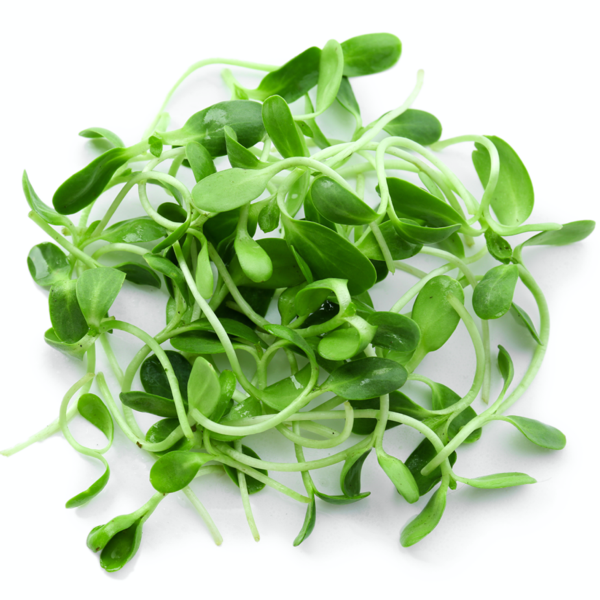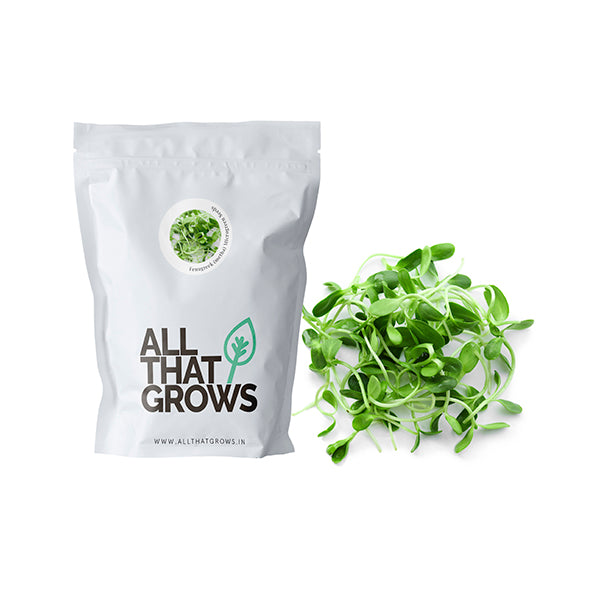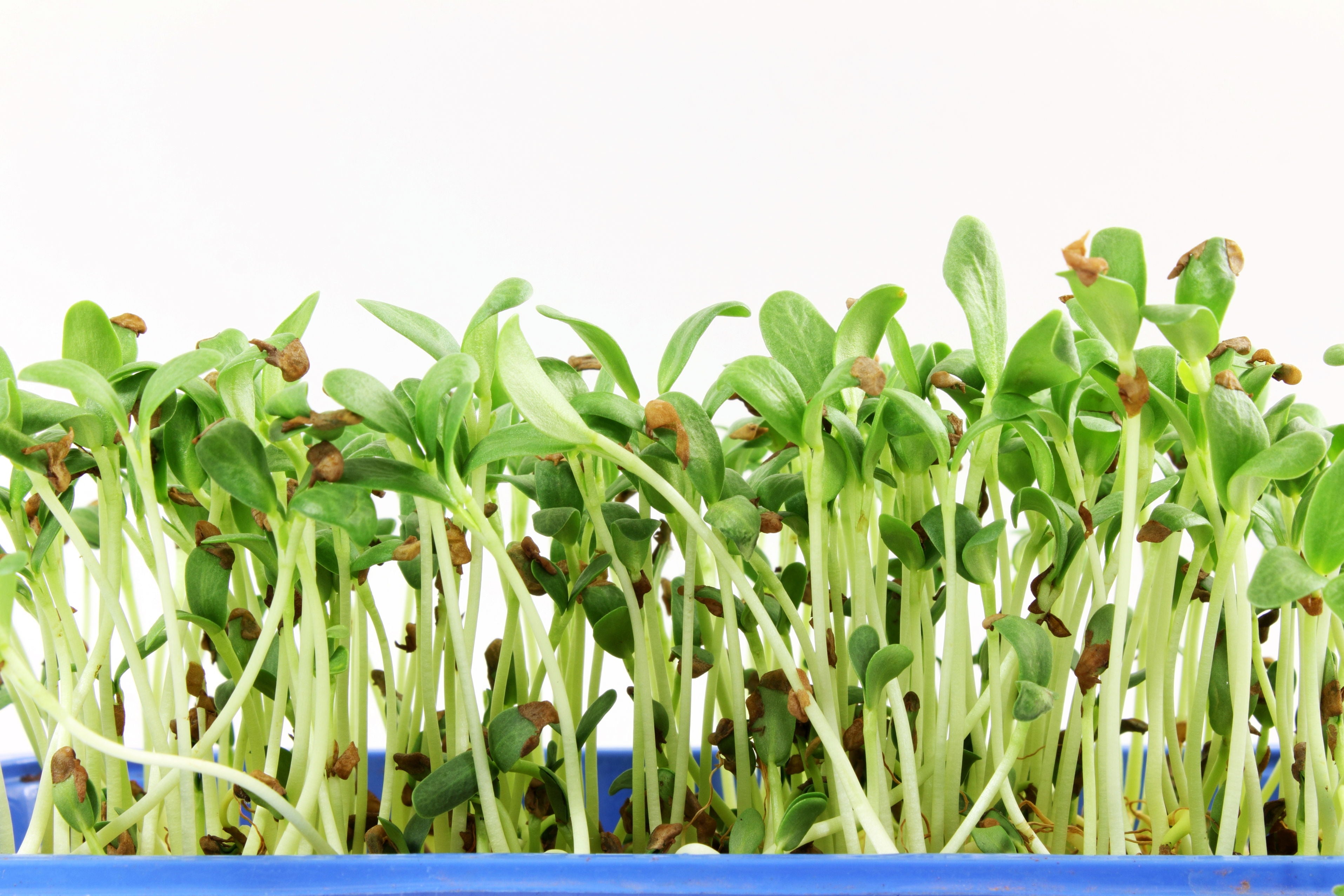





- SOWING
TIMEThroughout the year
- Sowing
DistanceN/A
- Fruit
WeightN/A
- Fruit
ShapeSmall tiny leaves with shoots
- Days to
maturity10-14 days
- Details
- How to sow
- Reviews
Fenugreek is most widely used in Indian cuisine, though it is also found in North African and Middle Eastern dishes. Fenugreek microgreen leaves are highly beneficial for treating poor liver functions and dyspepsia. It helps in controlling blood sugar levels as galactomannan, a natural soluble fiber present in Fenugreek slows down the rate of sugar absorption into the blood. It also contains amino acid responsible for inducing the production of insulin. Fenugreek is beneficial in the case of high blood levels of certain fats including cholesterol and triglycerides. It also helps in reducing menstrual discomfort and prevents colon cancer.
Planting instructions
Use a flat tray or a garden pot with a depth of 4 - 5 inches. Fill it up with potting or garden soil and mix in some manure or vermicompost. Sprinkle the seeds evenly and densely on the soil and cover them with a thin layer of soil.
Let the seeds germinate for at least 3-4 days in the shade. Once the seeds have matured into seedlings, expose them to sunlight and air by placing them either in the balcony or the kitchen on a window sill.
Fill it with potting soil and spread seeds on the surface, covering them with a thin layer of soil.
Allow the plant to germinate for 2 days.
Growing Requirements
soil
Fresh garden soil, free of any impurities or pebbles. Mix the soil with 30% manure or vermicompost for best results.
spot
4 to 5 hours of good sunlight
watering
Keep the top layer of the soil moist using a watering can or spray bottle by gently watering along the edges of the container you are growing them in. Water your microgreens thoroughly once a day is sufficient.
how to harvest
These tiny leafy greens are the best because they are fast-growing and are ready to be harvested within a mere 7-12 days. These plants can grow up to 3 inches tall but can be harvested earlier as well, depending upon your requirements. Use a sharp knife or scissors to cut the shoots just above the soil surface without damaging the roots.
Keep the soil dry 4-5 hours before harvesting the shoots. Don’t harvest immediately after watering the plants. Rinse the shoots with water before immediate consumption. Or you can even store them in the refrigerator in an air-tight container. But, microgreens lose their nutritional value over time, so it is advisable to consume them immediately after harvesting.
To grow the next batch of microgreens, decompose the used soil, collect fresh soil in a container, and repeat the same planting process.
Wash the microgreens, pot harvest and they are ready to eat.

Customer Reviews
The productiveness of any seed we sell is subject to your local climatic conditions*, the sowing method you adopt, and your commitment to the planting process. We give no warranty, expressed or implied, and are in no way responsible for the produce.
Please note that all our seasonal recommendations/ sowing information is as per the local climatic conditions. *For more information on the optimum conditions required for growing seeds in your region, please contact us at, hello@allthatgrows.in or Whatsapp us at, +91 8544865077
Questions & Answers
Have a Question?
Be the first to ask a question about this.






Fenugreek (Metha) Microgreen Seeds
Seed Type : Non-Hybrid, Open Pollinated and Non-GMO
Seed Pre Soak : No
Growing Medium : Soil / hydroponic
Flavour : Crunchy and mild
Colour : Light Green and white stems
Grow this with
Fenugreek is most widely used in Indian cuisine, though it is also found in North African and Middle Eastern dishes. Fenugreek microgreen leaves are highly beneficial for treating poor liver functions and dyspepsia. It helps in controlling blood sugar levels as galactomannan, a natural soluble fiber present in Fenugreek slows down the rate of sugar absorption into the blood. It also contains amino acid responsible for inducing the production of insulin. Fenugreek is beneficial in the case of high blood levels of certain fats including cholesterol and triglycerides. It also helps in reducing menstrual discomfort and prevents colon cancer.
Seed Type : Non-Hybrid, Open Pollinated and Non-GMO
Seed Pre Soak : No
Growing Medium : Soil / hydroponic
Flavour : Crunchy and mild
Colour : Light Green and white stems
- SOWING
TIMEThroughout the year
- Sowing
DistanceN/A
- Fruit
WeightN/A
- Fruit
ShapeSmall tiny leaves with shoots
- Days to
maturity10-14 days
Planting instructions
Use a flat tray or a garden pot with a depth of 4 - 5 inches. Fill it up with potting or garden soil and mix in some manure or vermicompost. Sprinkle the seeds evenly and densely on the soil and cover them with a thin layer of soil.
Let the seeds germinate for at least 3-4 days in the shade. Once the seeds have matured into seedlings, expose them to sunlight and air by placing them either in the balcony or the kitchen on a window sill.
Fill it with potting soil and spread seeds on the surface, covering them with a thin layer of soil.
Allow the plant to germinate for 2 days.
Growing Requirements
soil
Fresh garden soil, free of any impurities or pebbles. Mix the soil with 30% manure or vermicompost for best results.
spot
4 to 5 hours of good sunlight
watering
Keep the top layer of the soil moist using a watering can or spray bottle by gently watering along the edges of the container you are growing them in. Water your microgreens thoroughly once a day is sufficient.
how to harvest
These tiny leafy greens are the best because they are fast-growing and are ready to be harvested within a mere 7-12 days. These plants can grow up to 3 inches tall but can be harvested earlier as well, depending upon your requirements. Use a sharp knife or scissors to cut the shoots just above the soil surface without damaging the roots.
Keep the soil dry 4-5 hours before harvesting the shoots. Don’t harvest immediately after watering the plants. Rinse the shoots with water before immediate consumption. Or you can even store them in the refrigerator in an air-tight container. But, microgreens lose their nutritional value over time, so it is advisable to consume them immediately after harvesting.
To grow the next batch of microgreens, decompose the used soil, collect fresh soil in a container, and repeat the same planting process.
Wash the microgreens, pot harvest and they are ready to eat.



 Sign In
Sign In








